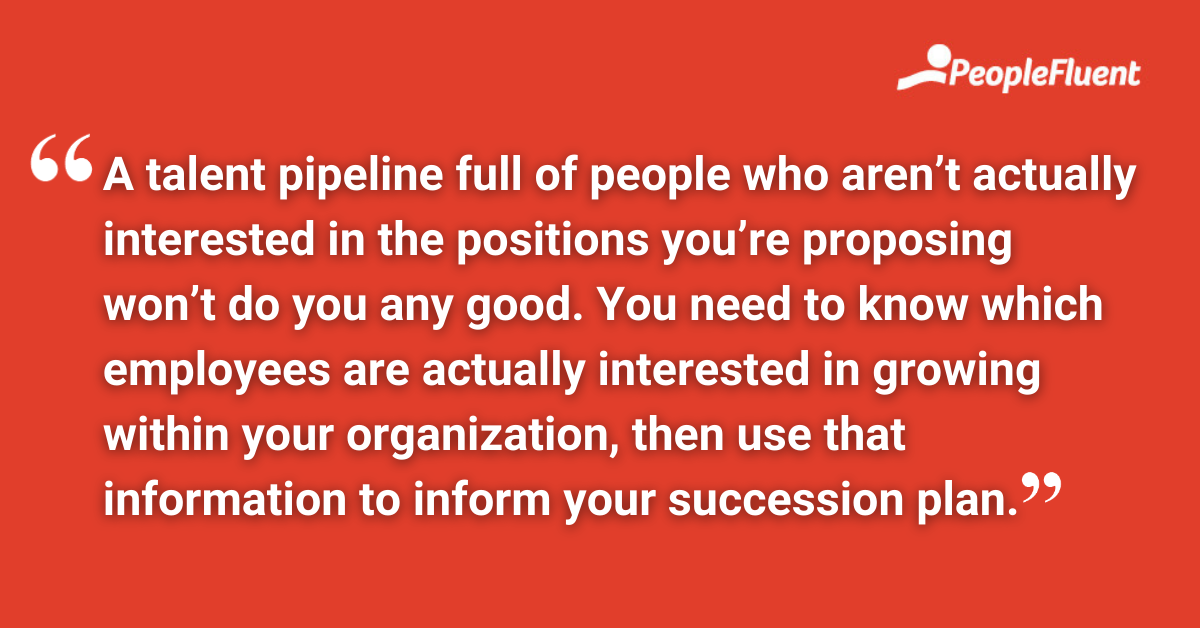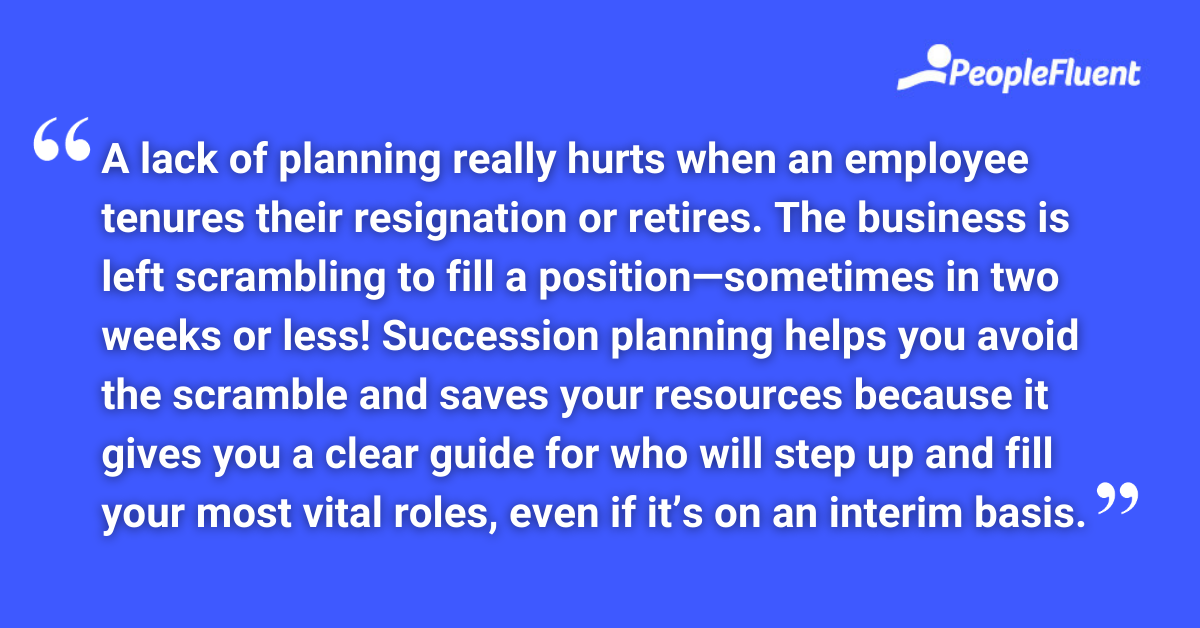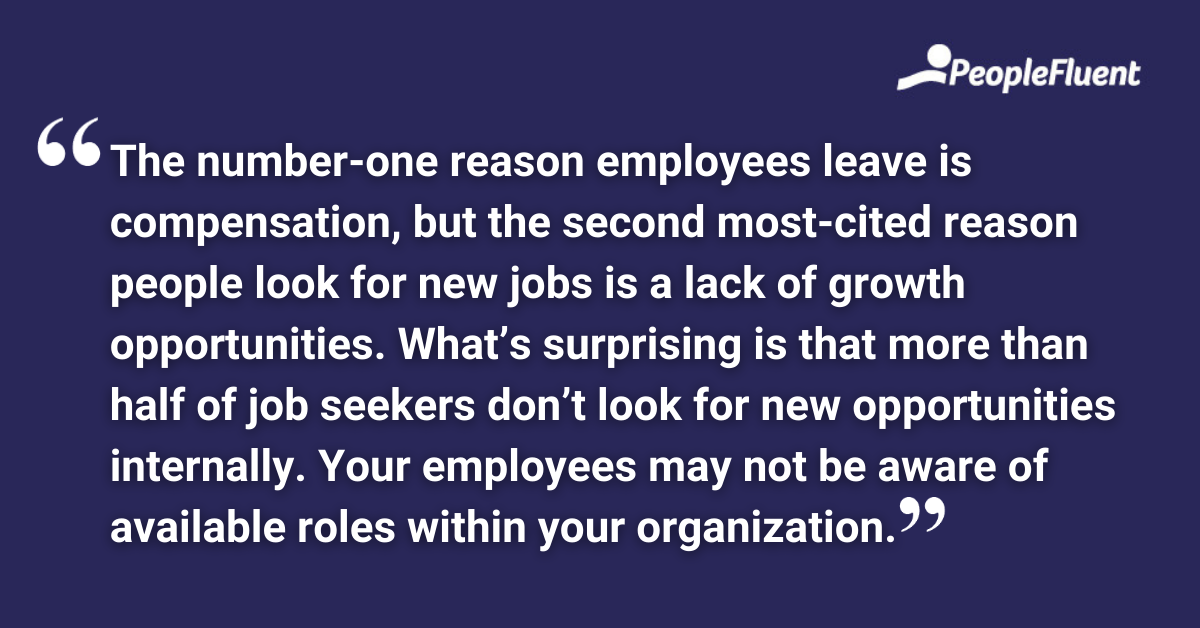Published: May 19, 2022Time to read: 6mins Category: Talent Management
Succession Planning and Talent Mobility: How to Combine Them to Build Your Talent Pipeline and Retain Employees
Employee movement is inevitable, and you shouldn’t spend valuable time developing a plan that doesn’t come to pass. Maintain continuity in your organization by creating a plan that empowers employees and keeps their professional ambitions in mind while meeting organizational goals. Read on to discover how merging succession planning with talent mobility will give your organization the best of both worlds.
According to the U.S. Bureau of Labor Statistics, approximately 4.5 million people quit their jobs in March 2022, and 11.5 million jobs remain unfilled. These record-breaking numbers indicate the need for organizations to be prepared for turnover. People are seeking new opportunities more than ever before, and businesses need to be ready.
Unfortunately, over half of HR professionals report that their organizations don’t have a succession plan in place. That’s pretty surprising—especially considering that people are leaving their jobs in droves. Although you might not be able to prevent employees from leaving, you can save yourself from some headaches by having a talent pipeline in place for the most vital positions within your organization.
The key to creating a useful succession plan is understanding the ambitions of your workforce. A talent pipeline full of people who aren’t actually interested in the positions you’re proposing won’t do you any good. You need to know which employees are actually interested in growing within your organization, then use that information to inform your succession plan.
Let’s dive deeper into how succession planning and talent mobility software can help keep your organization future-ready.

LEARN MORE | ‘6 Foundations for Effective Succession Planning’
Employee Succession Planning Keeps Talent in the Pipeline
We can think of succession planning as a focused process for keeping talent in the pipeline, and it’s a process from which organizations of all sizes can benefit. When done well, a succession plan can promote employee engagement and retention as well as organizational goals.
A lack of planning really hurts when an employee tenures their resignation or retires. The business is left scrambling to fill a position—often in just two weeks or less in the US! Succession planning helps you avoid the scramble and saves your resources because it gives you a clear guide for who will step up and fill your most vital roles, even if it’s on an interim basis.
Creating a succession plan takes time and careful consideration. It’s important to look at both the short and long term when considering who within your organization might be the best fit for future roles. It’s also important to note that not every position within your business needs to have a formal plan.
Let’s say you own a shipping company with hundreds of drivers. When one driver resigns or retires, you likely won’t need a detailed succession plan for that person’s role. The workload can be distributed among the other drivers until the position is filled. The same probably can’t be said if one of your managers leaves. Fewer people are in those positions, and the responsibilities are vastly different. Since working on the plan involves so many moving parts, it’s best to focus your efforts on positions with more individualized responsibilities that would be difficult to redistribute.
Once you’ve identified the key positions in your organization, it’s time to find the prospects in your workforce who can meet your needs and continue to work toward the company’s vision. This is where your talent mobility software comes in handy. A succession plan is no good if your prospective candidates aren’t interested in filling these positions someday. Talent mobility software provides you with valuable information about your employees’ short-term and long-term career goals. Knowing these things can save you time, money, and energy in the long run when developing your succession plans.

HAND-PICKED FOR YOU | ‘What Is Talent Mobility? Plus, What It’s Not!’
Talent Mobility Data Informs Your Plan
The number-one reason employees leave is compensation (27%), but the second most-cited reason people look for new jobs is a lack of growth opportunities (20%). What’s surprising is that more than half of job seekers don’t look for new opportunities internally. Your employees may not be aware of available roles within your organization.
That’s where talent mobility comes in. At its core, talent mobility is how your organization understands the skills, experiences, and career interests of your employees. The overarching goal is to move employees into new roles internally, where existing skills can be sharpened and new skills can be developed. Since employees are 62% more likely to stay with a company after making a lateral move, it’s vital that your organization shows its workforce any available roles within the organization.
This means gathering information to develop a career framework and skills taxonomy, which helps your employees understand the career options within your organization that align with their skills and interests. Sophisticated talent mobility software gathers data from your employees via resumes or LinkedIn profiles. The software then uses that data to show an employee the careers and active, internal job postings in your organization that align with that person’s skills and experience.
The right software can also be used to connect your employees with mentors within the organization who are willing to assist someone with honing their skills. These mentors will help prepare other employees for future roles.
Not only that, but talent mobility software can recommend projects and learning content available within your organization that helps employees develop specific skills to help them reach their long-term career goals.
That’s great news for your succession plan!

MORE FROM THE BLOG | ‘Moving On Up: 3 Ways You Can Build a Talent Marketplace to Solve Internal Mobility Challenges’
Succession and Talent Go Hand in Hand
Upskilling and reskilling take considerable time and effort. The data from your talent mobility software will allow you to focus your efforts on the employees who already express interest in the most pivotal roles at your organization. You’ll save time by matching willing mentors with interested employees. When the time comes for those mentors to leave, you’ll already have skilled, talented candidates in your pipeline ready to transition into a new role.
And the best part is, they’ll want to be there!
KEEP READING | ‘The Widening Workplace Skills Gap and How to Address It’
Be Future-Ready With a Data-Driven Succession Plan Aligned With Employee Skills
Learn about your employees. Prepare for the future. See how it all works with PeopleFluent Succession and PeopleFluent Talent Mobility by requesting a demo today!